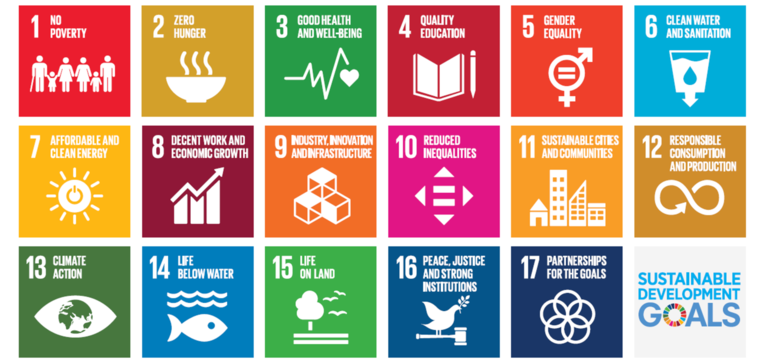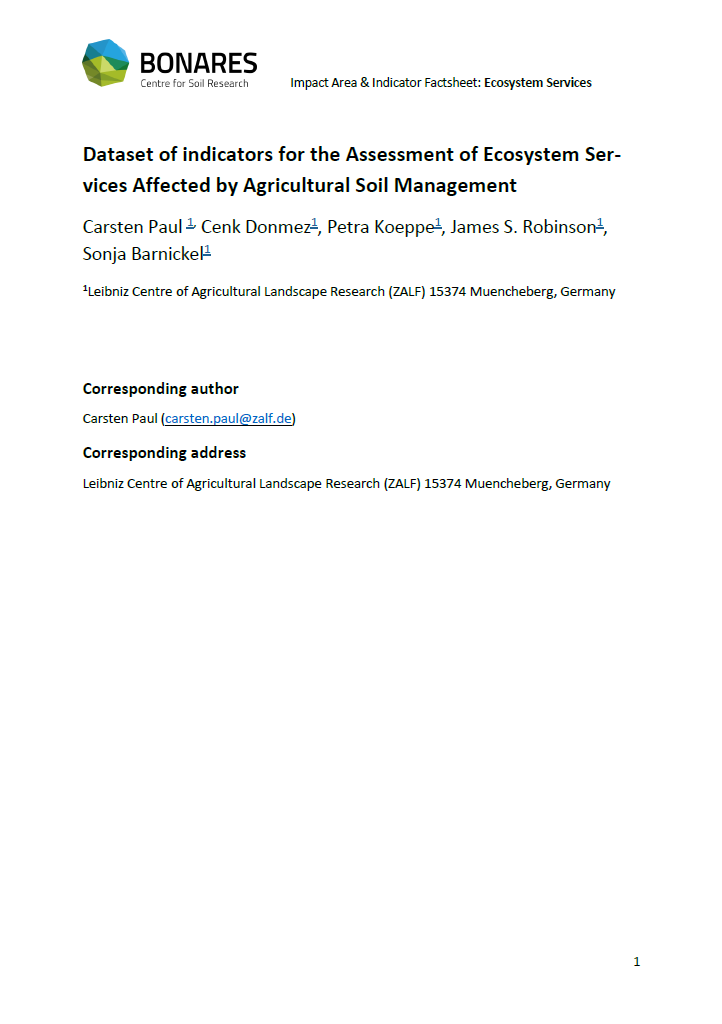How to use the BonaRes Factsheet Selection
If you want to conduct an impact assessment related to agricultural soil management, our Indicator Factsheets can be useful to determine relevant indicators and how they can be quantified. We compiled factsheets with information about indicators used in literature, the spatial scale they are suitable at, and the type of data they require. Before a factsheet can be provided, one of the Assessment Perspectives Ecosystem Services (ES) or Resource Use Efficiency (RUE) must be chosen.
Below you can find an example for a factsheet with explanations (green boxes).

Factsheet example (first page)

Factsheet example (second page)
Ecosystem Services
For structuring the impact areas related to the supply of ecosystem services, we use the Common International Classification of Ecosystem Services (CICES). It uses a hierarchical classification and represents a standard that facilitates comparability and upscaling of ecosystem service research. More information on the CICES classification can be found under www.cices.eu.
Ecosystem Services - Factsheet Selection
Please click on the links below to select a factsheet. The links with the blue background are the five most frequently assessed ecosystem services in studies on the impact of agricultural soil management (see Paul et al. 2022).
1. Biotic: Provisioning Services
2. Biotic: Regulation and Maintenance Services
3. Biotic: Cultural Services
4. Abiotic: Provisioning Services
5. Abiotic: Regulation & Maintenance Services
6. Abiotic: Cultural
The concept of ecosystem services aims at demonstrating the value of nature for human societies (Costanza et al., 1997, 2017; MEA, 2005; Haines-Young & Potschin, 2013; Potschin-Young et al., 2017; TEEB 2010). Ecosystem services can be seen as arising from the interaction of biotic and abiotic processes, and refer specifically to the ‘final’ outputs of ecological systems, i.e., the goods and services directly consumed or used by people (Haines-Young & Potschin, 2013; Potschin-Young et al., 2017). According to the cascade model, first introduced by Haines-Young & Potschin (2010), ecosystem services are based on biophysical structures or processes and the functions they serve. From ecosystem services humans generate benefits and values. Figure 1 shows the full cascade, starting from a biophysical structure or process and leading to values for humans. Additionally, the figure provides a soil related example.

Figure 1: Ecosystem service cascade model and example for a soil related cascade. Own representation based on Potschin & Haines-Young (2011)
In the context of impact assessments, we consider those ecosystem services to be soil related that are either based exclusively on soil functions (i.e. purification of water during its passage through the soil matrix), or where soil functions make a significant contribution to the final service (i.e. aboveground habitats created by plants growing in the soil.). Both types of soil related ecosystem services have in common that they are affected by agricultural management.
Impact assessments need to account for the fact that agricultural management always implies trade-offs between different ecosystem services. Each management option will enhance the provision of some ecosystem services while reducing the provision of others. Where impact assessments only consider a selected number of services, this selection may therefore already determine the assessment results. Depending on which ecosystem services are considered, assessments will find different policy options to have the most positive impacts. Sound research design is required to safeguard against such arbitrariness and potential for manipulation (see section on Impact Area Selection), and to instead highlight the trade-offs between options.
Costanza R, d'Arge R, de Groot R, Faber S, Grasso M, Hannon B, Limburg K, Naeem S, O'Neill R, Paruelo J, Raskin R, Sutton P, van den Belt M. 1997. The value of the world's ecosystem services and natural capital. Nature 387 (6630): 253–260.
Haines-Young R, Potschin M B. 2010. The Links Between Biodiversity, Ecosystem Services and Human Well-Being. In: Raffaelli D, Frid C (eds.) Ecosystem Ecology: A New Synthesis. Ecological Reviews, Cambridge University Press, Cambridge, United Kingdom, 110–139. DOI:10.1017/CBO9780511750458.007
Haines-Young R, Potschin M B. (2018): Common International Classification of Ecosystem Services (CICES) V5.1 and Guidance on the Application of the Revised Structure. Available from www.cices.eu
Helming, K., K. Diehl, D. Geneletti, H. Wiggering. 2013. Mainstreaming ecosystem services in European policy impact assessment. Environmental Impact Assessment Review 40:82-87.
MEA (Millennium Ecosystem Assessment). 2005. Ecosystems and Human Well-being: Synthesis. Island Press: Washington, DC.
Potschin-Young M, Haines-Young R, Görg C, Heink U, Jax K, Schleyer C. 2017. Understanding the role of conceptual frameworks: Reading the ecosystem service cascade. Ecosystem Services. DOI:10.1016/j.ecoser.2017.05.015
TEEB (The Economics of Ecosystems and Biodiversity). 2010. Mainstreaming the Economics of Nature: A Synthesis of the Approach, Conclusions and Recommendations of TEEB. Online: https://bit.ly/1UkiSrI (accessed 09 August 2019)
Resource Use Efficiencies (RUE)
Resource use efficiency is the ratio of benefits generated and the amount of resources used for this. Resource use efficiencies are calculated for resources that are either limited (e.g., land, water, energy) or that may create conflicts with other societal targets (e.g., pesticides, greenhouse gas emissions). Based on a review of scientific literature, we identified resource use efficiencies relevant in the context of agricultural soil management.
Resource Use Efficiency - Factsheet Selection
Please click on one of the links below to select an indicator factsheet. The links with the green background are the five most frequently selected RUE indicators in assessments of agricultural soil management.
1. Aboveground biomass
2. Embodied Energy
3. Embodied Nitrogen
4. Financial Benefits
5. Grain/Fruit/Tuber yield
6. Sequestered Carbon
In the context of agricultural soil management, we define resource use efficiency as the ratio between benefits generated by agricultural production processes and the amount of stressed resources used.
As benefit, any quantifiable, positive characteristic of a product can be chosen. This choice exerts a strong influence on calculated efficiencies and often determines efficiency rankings between production alternatives. For example, if weight of harvested biomass is considered, growing strawberries is less efficient than growing ryegrass whereas the situation is reversed if the evaluation is based on gross profits.
As resource, any of the resources used in the production process can be chosen. Here, the system boundaries must be clearly defined because substantial resource consumption can occur in pre- or post-processes related to the process under investigation. For example, if energy efficiency is assessed, it is relevant whether or not energy used in the production of inputs or machinery is considered. Finally, leakage effects, indirect land use changes and especially rebound effects should be accounted for (Lambin & Meyfroidt, 2011).
The resource use efficiency of agricultural soil management can be assessed by means of efficiency indicators, calculated as the ratio between the amount of benefit generated and the amount of resources used. What type of efficiency indicator is assessed, i.e. the selection of which benefits and which resource use are to be compared, should be based on the intended result of the agricultural management, its main inputs, and the characteristics of management alternatives. More than one efficiency indicator may be required for a comprehensive assessment or to show trade-offs between different types of efficiency.
Combining multiple benefits or resources
For combining multiple benefits and resources, assessments can either use multiple efficiency indicators, or apply a single indicator in which multiple benefits or resources are combined. The most common method to create combined indicators is to express all benefits or resources in monetary terms, based on their explicit or implicit market value. Alternative methods are often based on benchmarking. In detailed impact assessment, the use of multiple efficiency indicators may be preferable because they make trade-offs between different efficiency categories directly visible whereas such relationships may be obscured in the values of combined indicators.
Baveye P C, Baveye J, Gowdy J (2016) Soil“ecosystem”services and natural capital: critical appraisal of research on uncertain ground. Frontiers in Environmental Science, 4, article 41. doi:10.3389/fenvs.2016.00041
Di Maio F, Rema PC, Baldé K, Polder M (2017) Measuring resource efficiency and circular economy: A market value approach. Resources, Conservation and Recycling, 122. 163–171. doi:10.1016/j.resconrec.2017.02.009
Lambin EF, Meyfroidt P (2011) Global land use change, economic globalization, and the looming land scarcity. PNAS, 108 (9), 3465–3472. doi:10.1073/pnas.1100480108
Sustainable Development Goals

Sustainable Development Goals
The Sustainable Development Goals (SDG) are a set of goals and targets to be reached by 2030, agreed upon by, and requiring action from all United Nations (UN) member states. Soil functions play an important role for the realisation of multiple targets and underpin the achievement of the SDG agenda as a whole. Although the UN indicators for measuring progress on these targets are designed at the global level, successful achievement of the agenda requires national, regional and local efforts. It is therefore important to also connect the SDGs to effects of policy and management options at these levels.
Sustainable Development Goals - Factsheet Selection
There are 17 SDGs in total, each with multiple underlying SDG targets. We connected relevant SDG targets to the impact areas of Resource Use Efficiency and Ecosystem Services in agricultural soil management. Please note, however, that this alignment is not as methodologically robust as the processes used to identify indicators for Resource Use Efficiency and Ecosystem Services. You can select indicator factsheets based on Sustainable Development Goals by clicking on the link below.
The Sustainable Development Goals (SDG) are a set of goals and targets to be reached by 2030, agreed upon by, and requiring action from all United Nations (UN) member states. Soil functions play an important role for the realisation of multiple targets and underpin the achievement of the SDG agenda as a whole. There are 17 SDGs in total which include goals to end poverty and hunger, combat inequality and injustice, and tackle climate change by 2030 (see image above). The 17 goals are “integrated and indivisible”, designed to balance the three dimensions of sustainable development: the economic, social and environmental (UN, 2016).
The UN indicators for measuring progress towards SDGs are designed for impact assessment at the global level and therefore do not directly relate to local, regional or even national decisions. However, successful achievement of the agenda requires efforts at every level in all UN member states. It is therefore important to draw connections between management options and the relevant SDG targets. The BonaRes Assessment Platform supports this by highlighting 25 SDG targets that are directly connected to agricultural management and impact areas under the assessment perspectives of soil related ecosystem services and agricultural resource use efficiency.
United Nations. 2016. Resolution 70/1. Transforming our world: The 2030 agenda for sustainable development. Online: http://bit.ly/1Y3D3sN (accessed 09 August 2019)


